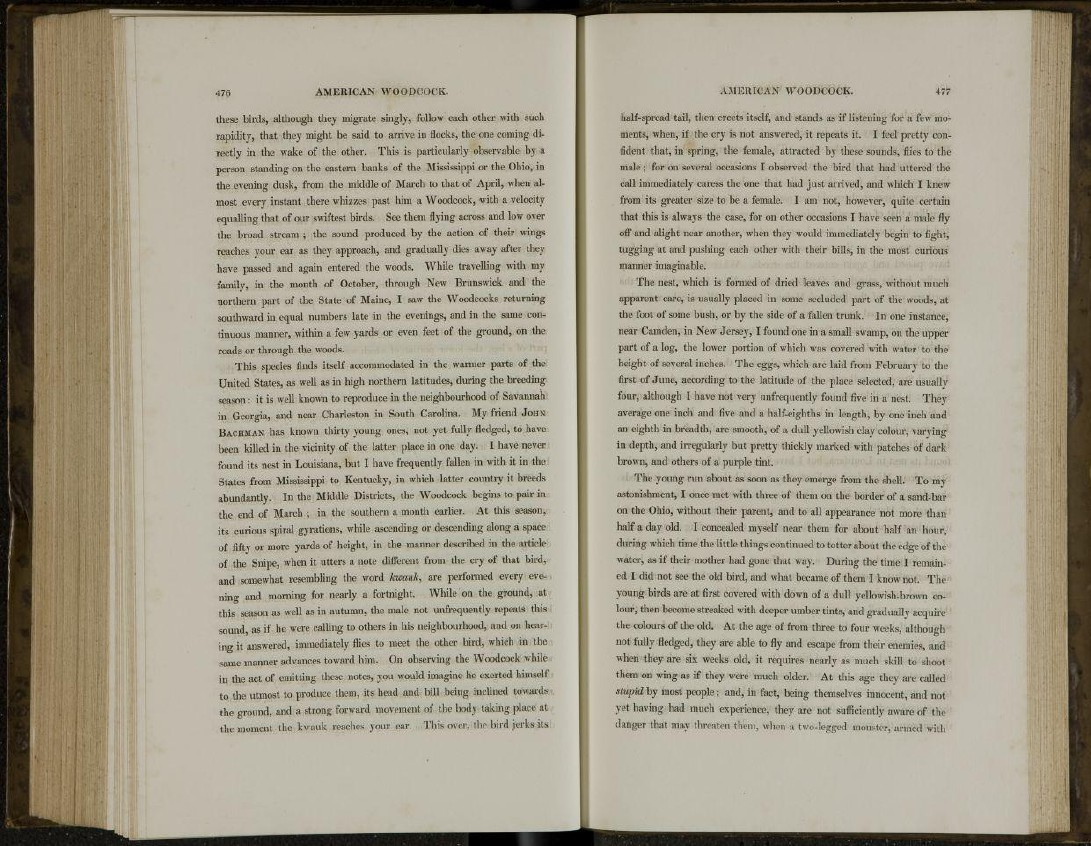
these birds, although they migrate singly, follow each other with such
rapidity, that they might be said to arrive in flocks, the one coming directly
in the wake of the other. This is particularly observable by a
person standing on the eastern banks of the Mississippi or the Ohio, in
the evening dusk, from the middle of March to that of April, when almost
every instant there whizzes past him a Woodcock, with a velocity
equalling that of our swiftest birds. See them flying across and low over
the broad stream ; the sound produced by the action of their wings
reaches your ear as they approach, and gradually dies away after they
have passed and again entered the woods. While travelling with my
family, in the month of October, through New Brunswick and the
northern part of the State of Maine, I saw the Woodcocks returning
southward in equal numbers late in the evenings, and in the same continuous
manner, within a few yards or even feet of the ground, on the
roads or through the woods.
This species finds itself accommodated in the warmer parts of the
United States, as well as in high northern latitudes, during the breeding
season: it is well known to reproduce in the neighbourhood of Savannah
in Georgia, and near Charleston in South Carolina. My friend JOHN
BACHMAN has known thirty young ones, not yet fully fledged, to have
been killed in the vicinity of the latter place in one day. I have never
found its nest in Louisiana, but I have frequently fallen in with it in the
States from Mississippi to Kentucky, in which latter country it breeds
abundantly. In the Middle Districts, the Woodcock begins to pair in
the end of March ; in the southern a month earlier. At this season,
its curious spiral gyrations, while ascending or descending along a space
of fifty or more yards of height, in the manner described in the article
of the Snipe, when it utters a note different from the cry of that bird,
and somewhat resembling the word kwauk, are performed every evening
and morning for nearly a fortnight. While on the ground, at
this season as well as in autumn, the male not unfrequently repeats this
sound, as if he were calling to others in his neighbourhood, and on hearing
it answered, immediately flies to meet the other bird, which in the
same manner advances toward him. On observing the Woodcock while
in the act of emitting these notes, you would imagine he exerted himself
to the utmost to produce them, its head and hill being inclined towards
the ground, and a strong forward movement of the body taking place al
the moment the kwauk reaches your ear. This over, the bird jerks its
half-spread tail, then erects itself, and stands as if listening for a few moments,
when, if the cry is not answered, it repeats it. I feel pretty confident
that, in spring, the female, attracted by these sounds, flies to the
male ; for on several occasions I observed the bird that had uttered the
call immediately caress the one that had just arrived, and which I knew
from its greater size to be a female. I am not, however, quite certain
that this is always the case, for on other occasions I have seen a male fly
off' and alight near another, when they would immediately begin to fight,
tugging at and pushing each other with their bills, in the most curious
manner imaginable.
The nest, which is formed of dried leaves and grass, without much
apparent care, is usually placed in some secluded part of the woods, at
the foot of some bush, or by the side of a fallen trunk. In one instance,
near Camden, in New Jersey, I found one in a small swamp, on the upper
part of a log, the lower portion of which was covered with water to the
height of several inches. The eggs, which are laid from February to the
first of June, according to the latitude of the place selected, are usually
four, although I have not very unfrequently found five in a nest. They
average one inch and five and a half-eighths in length, by one inch and
an eighth in breadth, are smooth, of a dull yellowish clay colour, varying
in depth, and irregularly but pretty thickly marked with patches of dark
brown, and others of a purple tint.
The young run about as soon as they emerge from the shell. To my
astonishment, I once met with three of them on the border of a sand-bar
on the Ohio, without their parent, and to all appearance not more than
half a day old. I concealed myself near them for about half an hour,
during which time the little things continued to totter about the edge of the
water, as if their mother had gone that way. During the time I remained
I did not see the old bird, and what became of them I know not. The
young birds are at first covered with down of a dull yellowish-brown colour,
then become streaked with deeper umber tints, and gradually acquire
the colours of the old. At the age of from three to four weeks, although
not fully fledged, they are able to fly and escape from their enemies, and
when they are six weeks old, it requires nearly as much skill to shoot
them on wing as if they were much older. At this age they are called
stupid by most people; and, in fact, being themselves innocent, and not
yet having had much experience, they are not sufficiently aware of the
clanger that may threaten them, when a two-legged monster, armed with